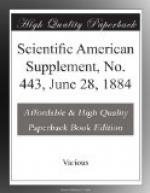Dust, then, being so universally prevalent, what do I mean by dust-free spaces? How are such things possible? And where are they to be found? In 1870 Dr. Tyndall was examining dusty air by means of a beam of light in which a spirit-lamp happened to be burning, when he noticed that from the flame there poured up torrents of apparently thick black smoke. He could not think the flame was really smoky, but to make sure he tried, first a Bunsen gas flame and then a hydrogen flame. They all showed the same effect, and smoke was out of the question. He then used a red-hot poker, a platinum wire ignited by an electric current, and ultimately a flask of hot water, and he found that from all warm bodies examined in dusty air by a beam of light the upstreaming convection currents were dark. Now, of course smoke would behave very differently. Dusty air itself is only a kind of smoke, and it looks bright, and the thicker the smoke the brighter it looks; the blackness is simply the utter absence of smoke; there is nothing at all for the light to illuminate, accordingly we have the blankness of sheer invisibility. Here is a flame burning under the beam, and, to show what real smoke looks like, I will burn also this spirit lamp filled with turpentine instead of alcohol. Why the convention currents were free from dust was unknown; Tyndall thought the dust was burnt and consumed; Dr. Frankland thought it was simply evaporated.
In 1881 Lord Rayleigh took the matter up, not feeling satisfied with these explanations, and repeated the experiment very carefully. He noted several new points, and hit on the capital idea of seeing what a cold body did. From the cold body the descending current was just as dark and dust-free as from a warm body. Combustion and evaporation explanations suffered their death-blow. But he was unable to suggest any other explanation in their room, and so the phenomenon remained curious and unexplained.
In this state Mr. Clark and I took the matter up last summer, and critically examined all sorts of hypotheses that suggested themselves, Mr. Clark following up the phenomena experimentally with great ingenuity and perseverance. One hypothesis after another suggested itself, seemed hopeful for a time, but ultimately had to be discarded. Some died quickly, others lingered long. In the examination of one electrical hypothesis which suggested itself we came across various




